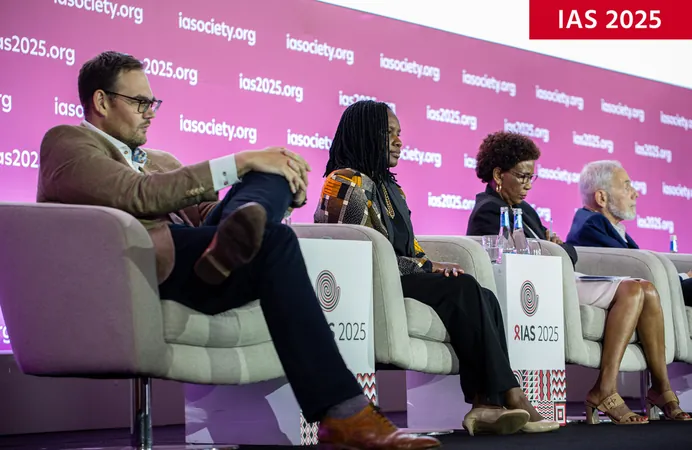
Severe US Funding Cuts Spark Alarming Drops in HIV Testing and Treatment
2025-07-21
Author: Wei Ling
A Disturbing Trend in Global HIV Efforts
Recent cuts in US funding for HIV programs have already triggered a shocking decline in testing and treatment initiatives across various countries, as presented at the 13th International AIDS Society Conference on HIV Science (IAS 2025) in Kigali. If these funding reductions persist, predictions indicate a staggering increase of 10.8 million new HIV infections and 2.9 million additional deaths by 2030.
The Consequences of Funding Freezes
On January 21, 2025, the US government announced a pause in all foreign assistance through USAID, culminating in immediate job losses for thousands of HIV testing counselors and clinic staff. Vital medications became stranded, unable to reach pharmacies, exacerbating the crisis. Although a waiver was granted to fund PEPFAR treatment services, data from Mozambique and Johannesburg illustrates the swift negative impact on HIV testing and treatment starts.
Mozambique: A Closer Look at the Fallout
In Mozambique, where PEPFAR has covered nearly two-thirds of the HIV program funding for over a decade, about 2.2 million individuals live with HIV—the highest count globally after South Africa. A stark comparison between service activity in early 2024 and 2025 reveals concerning drops: treatment initiation fell by 14% with over 15,000 fewer people starting antiretroviral therapy from February to May 2025.
Testing Declines Amid Staffing Shortages
Viral load testing experienced a 38% decline in adults and a haunting 44% reduction in children, while viral suppression rates decreased significantly. The interruption of treatments—tracked through missed drug pickups—skyrocketed by 39% in just one month. However, researchers caution that this data may reflect gaps in reporting rather than an absolute increase.
The South African Situation: A Grim Analysis
Meanwhile, in South Africa’s Johannesburg, a decrease in USAID funding—which had been instrumental in improving HIV testing and treatment rates—led to an 8.5% reduction in testing, a 31% drop in diagnoses, and a 30% decline in treatment initiation. The Anova Health Institute’s graphic presentation painted a bleak picture of healthcare worker shortages and diminished outreach opportunities for at-risk communities.
A Global Perspective: The Broader Impact of Funding Cuts
It’s not just the US cutting aid; the UK and France anticipate a significant 40% reduction in foreign assistance by 2026, with the Netherlands planning a 70% decrease. As the leading provider of international HIV aid, the US accounted for 73% of all funding for low- and middle-income countries in 2023.
Projecting the Future of HIV with the UNAIDS Model
Researchers at the Burnet Institute in Melbourne utilized the UNAIDS Optima model to examine potential outcomes from these funding cuts across 26 key countries, accounting for nearly half of the global HIV population. Their alarming projections indicate that, without intervention, the reduction in funding could lead to an additional 71,500 to 1.7 million new HIV infections and between 5,000 to 61,000 extra deaths by 2030.
Who Will Suffer Most?
Key populations and children will be disproportionately affected, experiencing a 30-60% higher rate of infection compared to others outside Africa. If PEPFAR were to cease, an estimated 880,000 new infections and 120,000 deaths in children from low- and middle-income countries are predicted from 2025 to 2030.
The Fate of PEPFAR Funding Hangs in the Balance
As funding cuts threaten the fight against HIV worldwide, the critical role of programs like PEPFAR becomes increasingly evident. The coming years could redefine HIV healthcare availability and effectiveness, drawing urgent attention to the need for sustaining such lifelines.



 Brasil (PT)
Brasil (PT)
 Canada (EN)
Canada (EN)
 Chile (ES)
Chile (ES)
 Česko (CS)
Česko (CS)
 대한민국 (KO)
대한민국 (KO)
 España (ES)
España (ES)
 France (FR)
France (FR)
 Hong Kong (EN)
Hong Kong (EN)
 Italia (IT)
Italia (IT)
 日本 (JA)
日本 (JA)
 Magyarország (HU)
Magyarország (HU)
 Norge (NO)
Norge (NO)
 Polska (PL)
Polska (PL)
 Schweiz (DE)
Schweiz (DE)
 Singapore (EN)
Singapore (EN)
 Sverige (SV)
Sverige (SV)
 Suomi (FI)
Suomi (FI)
 Türkiye (TR)
Türkiye (TR)
 الإمارات العربية المتحدة (AR)
الإمارات العربية المتحدة (AR)